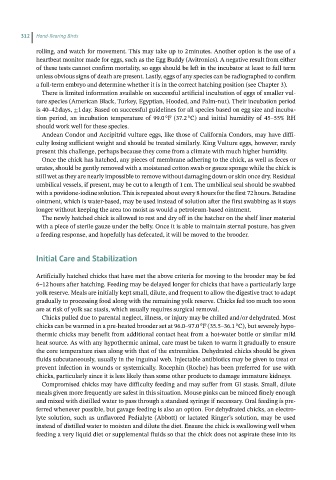Page 323 - Hand rearing birds second
P. 323
312 Hand-Rearing Birds
rolling, and watch for movement. This may take up to 2 minutes. Another option is the use of a
heartbeat monitor made for eggs, such as the Egg Buddy (Avitronics). A negative result from either
of these tests cannot confirm mortality, so eggs should be left in the incubator at least to full term
unless obvious signs of death are present. Lastly, eggs of any species can be radiographed to confirm
a full-term embryo and determine whether it is in the correct hatching position (see Chapter 3).
There is limited information available on successful artificial incubation of eggs of smaller vul-
ture species (American Black, Turkey, Egyptian, Hooded, and Palm-nut). Their incubation period
is 40–42 days, ±1 day. Based on successful guidelines for all species based on egg size and incuba-
tion period, an incubation temperature of 99.0 °F (37.2 °C) and initial humidity of 45–55% RH
should work well for these species.
Andean Condor and Accipitrid vulture eggs, like those of California Condors, may have diffi-
culty losing sufficient weight and should be treated similarly. King Vulture eggs, however, rarely
present this challenge, perhaps because they come from a climate with much higher humidity.
Once the chick has hatched, any pieces of membrane adhering to the chick, as well as feces or
urates, should be gently removed with a moistened cotton swab or gauze sponge while the chick is
still wet as they are nearly impossible to remove without damaging down or skin once dry. Residual
umbilical vessels, if present, may be cut to a length of 1 cm. The umbilical seal should be swabbed
with a povidone-iodine solution. This is repeated about every 8 hours for the first 72 hours. Betadine
ointment, which is water-based, may be used instead of solution after the first swabbing as it stays
longer without keeping the area too moist as would a petroleum-based ointment.
The newly hatched chick is allowed to rest and dry off in the hatcher on the shelf liner material
with a piece of sterile gauze under the belly. Once it is able to maintain sternal posture, has given
a feeding response, and hopefully has defecated, it will be moved to the brooder.
InitialCareand Stabilization
Artificially hatched chicks that have met the above criteria for moving to the brooder may be fed
6–12 hours after hatching. Feeding may be delayed longer for chicks that have a particularly large
yolk reserve. Meals are initially kept small, dilute, and frequent to allow the digestive tract to adapt
gradually to processing food along with the remaining yolk reserve. Chicks fed too much too soon
are at risk of yolk sac stasis, which usually requires surgical removal.
Chicks pulled due to parental neglect, illness, or injury may be chilled and/or dehydrated. Most
chicks can be warmed in a pre-heated brooder set at 96.0–97.0 °F (35.5–36.1 °C), but severely hypo-
thermic chicks may benefit from additional contact heat from a hot-water bottle or similar mild
heat source. As with any hypothermic animal, care must be taken to warm it gradually to ensure
the core temperature rises along with that of the extremities. Dehydrated chicks should be given
fluids subcutaneously, usually in the inguinal web. Injectable antibiotics may be given to treat or
prevent infection in wounds or systemically. Rocephin (Roche) has been preferred for use with
chicks, particularly since it is less likely than some other products to damage immature kidneys.
Compromised chicks may have difficulty feeding and may suffer from GI stasis. Small, dilute
meals given more frequently are safest in this situation. Mouse pinks can be minced finely enough
and mixed with distilled water to pass through a standard syringe if necessary. Oral feeding is pre-
ferred whenever possible, but gavage feeding is also an option. For dehydrated chicks, an electro-
lyte solution, such as unflavored Pedialyte (Abbott) or lactated Ringer’s solution, may be used
instead of distilled water to moisten and dilute the diet. Ensure the chick is swallowing well when
feeding a very liquid diet or supplemental fluids so that the chick does not aspirate these into its

